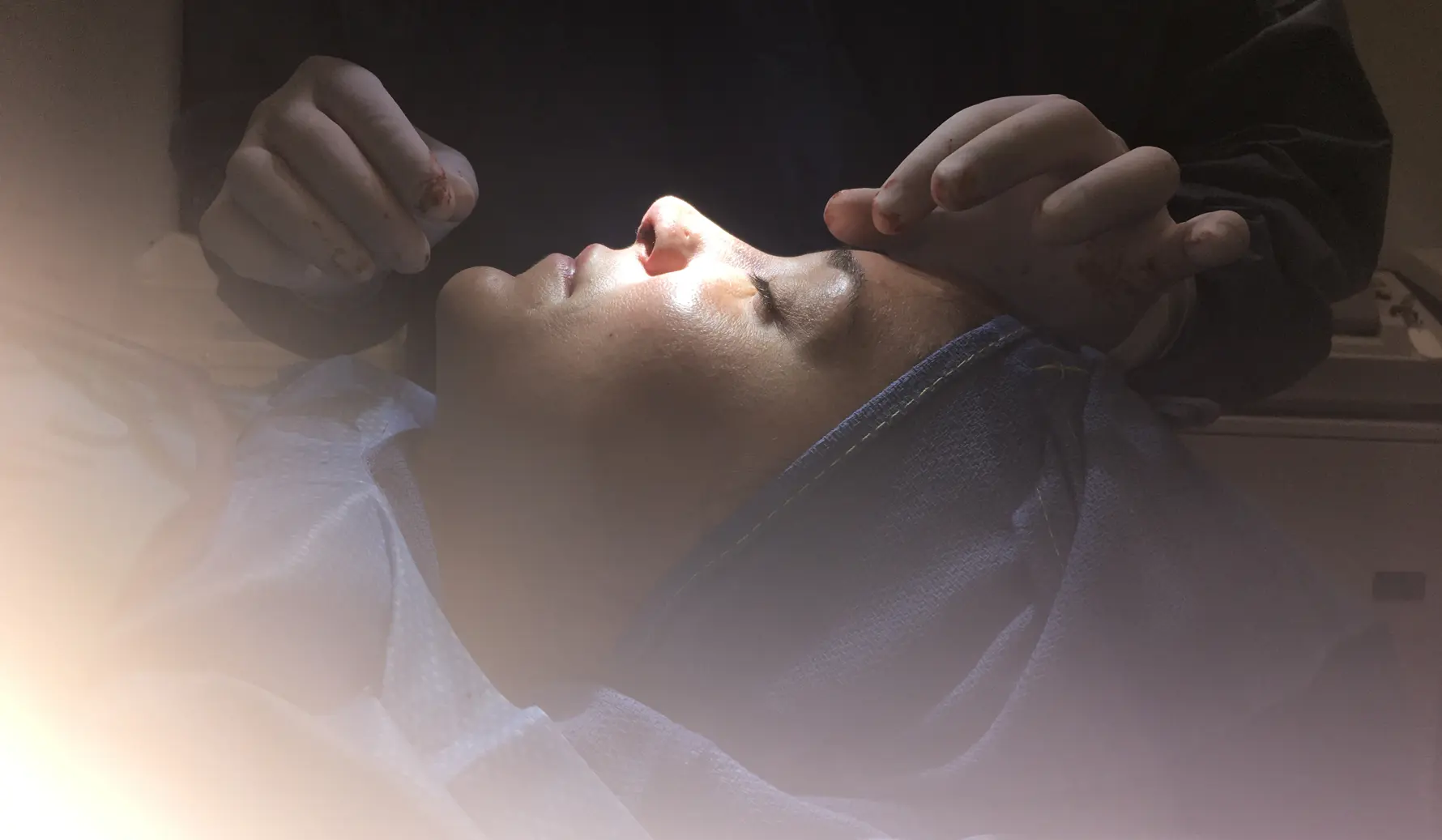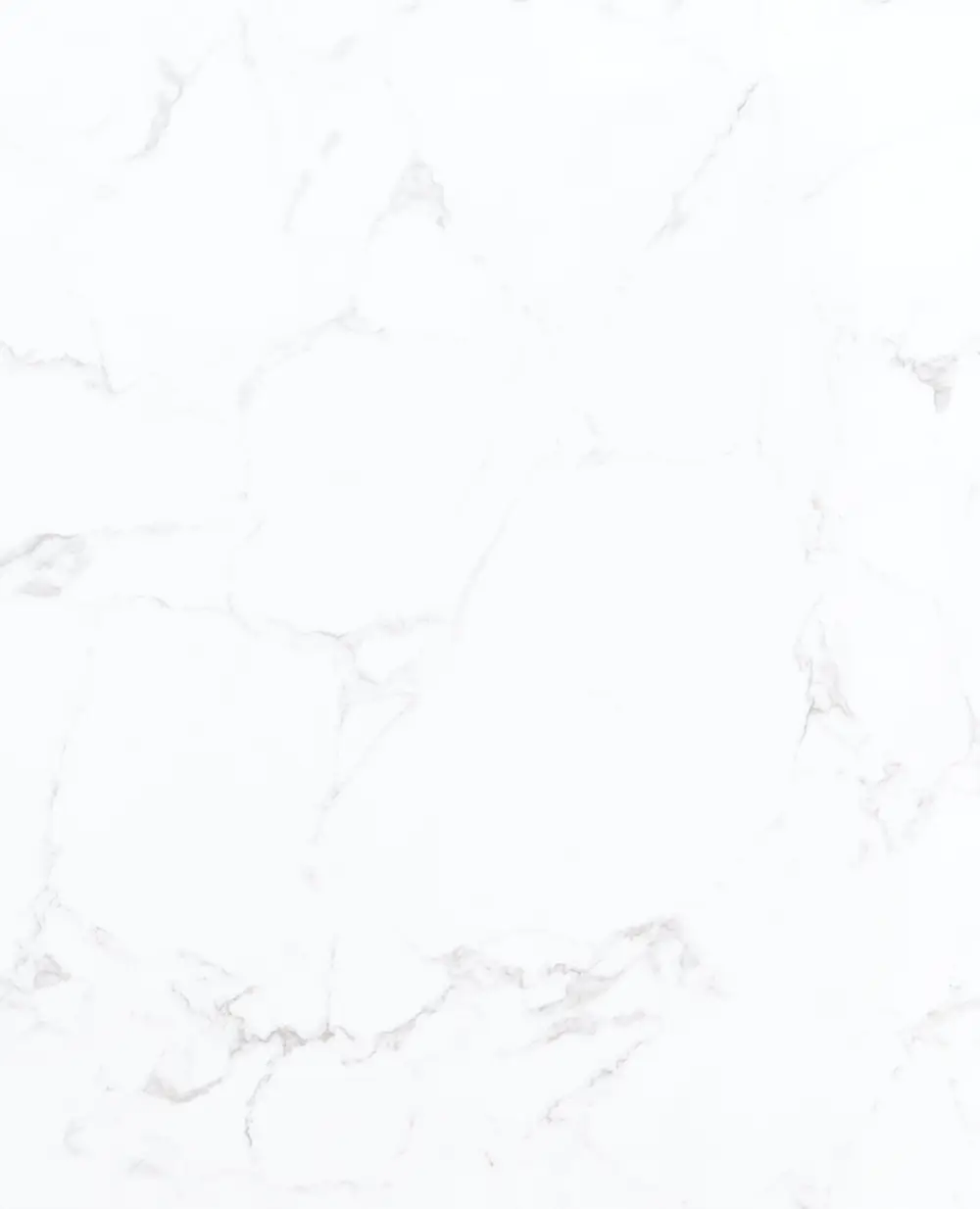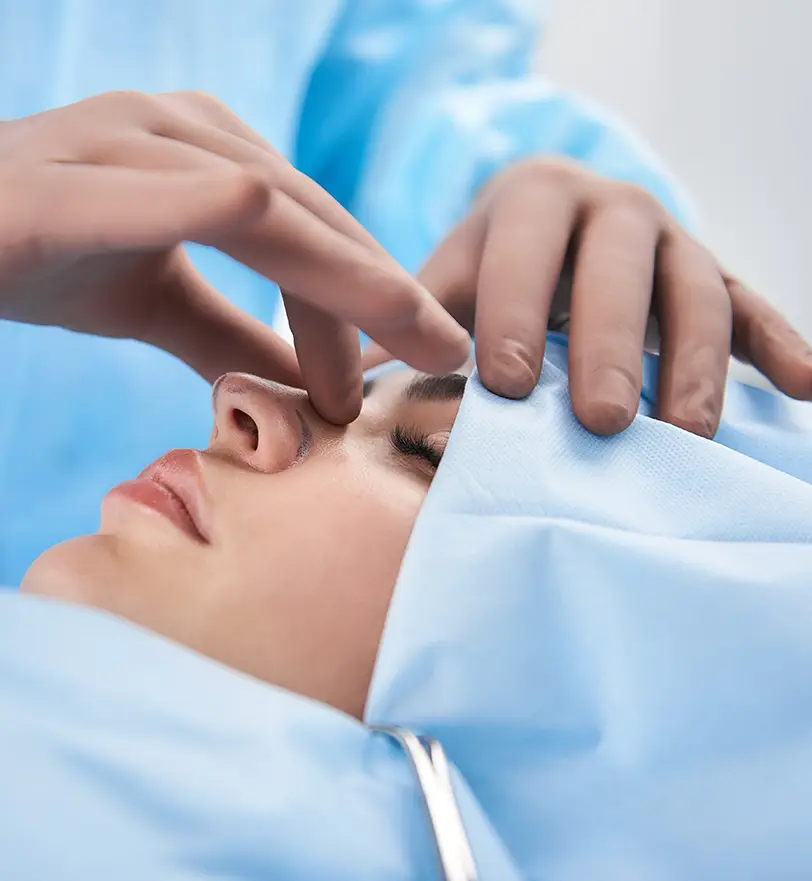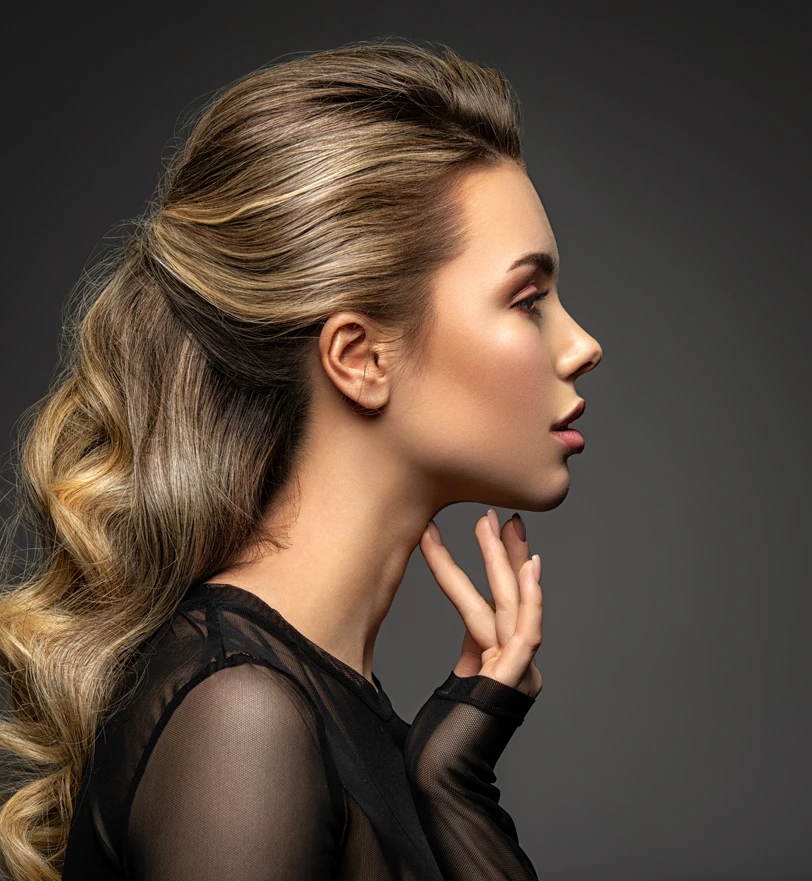
Revision Rhinoplasty has unfortunately become all too common these days. Dr. Zhuravsky takes this matter very seriously as he has witnessed how distressing it can be for patients.
We see various levels of revision rhinoplasty from all around the country at our office in Miami, helping patients achieve the nose they initially intended.


The Short answer:
Revision Rhinoplasty is a Rhinoplasty (nose job) that is performed after a prior surgery (or surgeries) has already been attempted.
The DETAILED answer:
Revision Rhinoplasty focuses on correcting aesthetic and functional problems that were either inadequately addressed or created by prior nose surgery. Overall, it is very similar to primary rhinoplasty as our main objective is to give patients a nose that will make them happy. However, revisions are much more complicated for a variety of reasons. While in primary surgery we are making changes to the natural structures of the nose, revision surgery adds the challenge of altered and damaged nasal bones and cartilage. As a result, we must have a greater arsenal of techniques and abilities to fix these problems while also achieving the desired shape. The revision also adds the issue of scar tissue, which can be very difficult to separate without damaging the structures of the nose any further.
The Short Answer:
Patients usually want Revision Rhinoplasty surgery because their initial results led to one or more of the following:
The Detailed Answer:
There are several different reasons that patients seek to have Revision Rhinoplasty surgery in Miami, and in some cases, it is a combination of these. Dr. Zhuravsky has found that at the heart of it, a vast majority of cases are from faster more generic type rhinoplasties that are performed either by those who do not specialize in rhinoplasty or those who do many rhinoplasties, in the same way, every time. Patients usually say things like “Well I was already getting my breasts done so did my nose also”, or “I thought it was JUST A NOSE JOB”. Here are some of the things that we tend to see, and the possible reasons for them.
Like primary Rhinoplasty, each case has to be examined individually with a thorough and candid discussion between the surgeon and the patient. Computer morphed imaging is very important in this process to help communicate the ideal outcomes. This allows the patient to visualize the realistic potential outcomes and see if they match up to a result that would make them happy. For Dr. Z, it allows him to fully understand the patient’s desires, as well as to advise and teach them.
The Short Answer:
Some of the common issues we deal with in Revision Rhinoplasty surgery are over-narrowed / collapsed nasal bridge, pinched tip, retracted nostrils, and the over or under-rotated tip.
The Detailed Answer:
Although each nose is unique, there are certain problems that we see more frequently than others in revision cases. Most of these issues occur from quicker, generic-type techniques that fail to recognize the true anatomy and ignore the concepts of shape and stability.
The Short Answer:
Generally, most people seeking revision are candidates, including those who:
It should be noted that although smoking and uncontrolled diabetes will not absolutely prevent you from having a revision rhinoplasty, they create concern for adequate healing and blood supply to an area where this is already a concern, and can lead to skin necrosis.
The DETAILED answer:
In order to know if you are a candidate for Revision Rhinoplasty in Miami, the first step is to understand what changes are possible and how those changes can be accomplished. This information is critical for someone to decide whether or not revision is worth pursuing, and it can only be obtained from having at least one good quality consultation with an experienced revision rhinoplasty specialist. Once a patient understands what changes can realistically be achieved, they can weigh this against the risks of additional surgery. This is why it is important to ask about expectations for results, surgery, and recovery.
I find that most revision rhinoplasty patients are good candidates as the changes they seek are realistic and lead to a significant improvement in their self-image/confidence. However, on occasion, some desire very subtle changes, which when demonstrated with computer-morphed images do not elicit any major changes in the way they feel about their appearance. In such cases, undergoing surgery may not be a great idea if it will not give much benefit to the patient overall. There are also cases where the desired changes cannot be accomplished due to the patient’s anatomy or due to limitations from the prior surgery. Additionally, there are certain cases of significantly increased risk for complications due to the nature of the previous surgery, and the changes may not be worth taking such risk.
The Short Answer:
Similar to primary Rhinoplasty, success is achieved by determining the ideal shape and size for the patient, understanding the anatomy of their current nose, knowing how that anatomy has to be changed to result in the desired appearance, and being able to perform the surgical techniques well.
The DETAILED answer:
Although a Miami Revision Rhinoplasty is more complicated and requires a greater skill set, the overall approach is similar to that of a successful primary Rhinoplasty. The first step is a thorough consultation to determine the ideal outcomes that will make the patient happy. The surgeon must listen to the patient and understand their aesthetic concerns. I find computer-morphed images to be a vital part of this process, as they allow me to visually demonstrate what I think the patient is telling me, while also showing them what I suggest to get the best results. This ensures clear communication, allowing the patient to see what the nose would look like and how it would impact their aesthetics.
The rest of the process relies on the surgeon. As rhinoplasty surgeons, we must first understand why the nose looks the way it does. The nose is made of bones and cartilage that are covered by a blanket of skin. The shape, size, orientation, and position of those parts relative to each other are responsible for the nasal appearance. We must determine how these characteristics are influencing the appearance and how we need them to change to get the appearance that the patient desires. What makes revisions more complicated is the added factor of prior surgery and how it influenced all these aspects.
The next step is to understand how the current anatomy must be changed to reflect the desired appearance. A good rhinoplasty surgeon knows many different techniques and maneuvers that can be used in various situations. In revisions, we must have an even wider arsenal of techniques as we are now dealing with artificial anatomy and have a greater variability of issues to correct. We are also dealing with cartilages that have often been weakened, cut, or completely removed, thus requiring significant grafting.
The last part is having the knowledge and ability to perform the required techniques specific to the patient’s needs. This is where the “artistic” side of things comes into play and is perhaps one of the more difficult concepts to explain. Doctors and Surgeons are initially taught in a bland problem/solution, or question/answer method that is somewhat robotic. In the nose, this would mean that when the surgeon encounters an issue, they try to answer the question of which technique can fix this problem. The right answers are important, but it is also vital to understand that each technique can be performed with subtle differences that can lead to significant changes in the final results.
The Short Answer:
Revision Rhinoplasty can be performed under local or general anesthesia similar to the way primary rhinoplasty is performed.
The DETAILED answer:
The overall approach to Revision Rhinoplasty in Miami is very similar to that of primary surgery. Whether it is open, closed, or preservation, we need to gain access to the nasal structure by lifting the skin. The majority of the nose is made of cartilage, so the focus of surgery is to change the size, shape, orientation, and/or relative position of the cartilage to achieve the desired outcomes. This is accomplished by cutting cartilage, moving them, changing their shape with sutures (stitches), and using cartilage from other areas to reinforce or augment certain areas. This is of course an oversimplification as there are hundreds of techniques/maneuvers that we can use, and a good rhinoplasty is like a puzzle that requires us to figure out the correct choices.
An important thing to note is that the “breaking the nose” part of the procedure is not what most people imagine it to be. This refers to changes we create in the bone of the nose, which is a very small part of the entire procedure and is more like making cuts in the bone, rather than “smashing” “shattering” or “crushing”.
When we do revisions, we often find that some of the cartilage has been excessively cut away, deformed, destabilized, or simply not treated with the proper techniques. Thus we often rely on cartilage grafting. This means we are taking cartilage from other areas (septum, ears, or ribs) to replace or reinforce the nasal cartilage and create the shape that we desire. Imagine fixing a house, but some of the walls have been damaged, destroyed, or warped. We would then have to get new materials to restore and renovate such issues. Cartilage is our building material and it can come from a variety of sources, including the septum, ears, or ribs. Another great option is to use irradiated rib cartilage from donors. The best options for each case should be discussed with the surgeon at consultation.
Ear cartilage is obtained by making an incision behind the ear, where it is well hidden and heals very well. The central part of the cartilage called the concha bowl is taken while leaving the important parts that give the ear its shape and structure. The ear will often be slightly closer to the head, which patients often prefer. In most cases, the more protruding ear is chosen for this reason.
The Short Answer:
The majority of the recovery is 1 week, with most patients being socially acceptable and being able to return to work or school at this point. Out-of-town patients usually fly home on day 7 as well. Many are even able to work from home or go out to dinner as early as 3 days after, as long as they don’t mind the swelling and splint on the outside of the nose.
The DETAILED answer:
Recovery for Revision Rhinoplasty in Miami is very similar to that of the primary surgery. One thing that our patients find pleasantly surprising is that Dr. Z does NOT use packing or splints inside the nose, which significantly reduces the discomfort. While many of our patients report that their pain is very mild and controlled with just Tylenol, the average expectation is for moderate pressure/pain that is controlled with the prescribed pain medication during the first 24 hours. A vast majority of patients switch to Tylenol as early as the morning after surgery. Swelling increases during the first 2- 3 days, then starts to improve significantly. While typically our patients experience very little to no bruising at all, it is possible to get the classic “double black eye” look. This usually fades away over the 1 week recovery period. If ear cartilage is taken, a head bandage is placed for 1-2 days to help prevent a hematoma.
Overall, patients are socially acceptable at the 7-day mark once the splint and sutures have been removed. There will of course be fullness and swelling, but not usually to the degree that attracts unwanted attention. The nose gets slightly more swelling during the first 24 hours after the splint is removed, then continues to decrease thereafter. The correction of most issues is apparent and the overall improved shape of the nose can be appreciated as early as 1 week, so most patients are happy with the results even with this swelling.
Our out-of-state patients fly home on the day of splint removal (day 7).


Dr. Zhuravsky is a board-certified facial plastic surgeon with specialized expertise in Rhinoplasty and Revision Rhinoplasty in Miami. The ability to perform rhinoplasty well cannot simply be taught. It is something that surgeons need to develop, constantly learning and re-evaluating their results as well as those of others. Dr. Zhuravsky was very lucky to have some wonderful mentors, but it was what came after his initial training that turned him from a good rhinoplasty surgeon into a great one. Driven by the desire to make sure that each and every result was the absolute best that it could be, Dr. Z constantly pushed forward to expand and sharpen his skills. He is a firm believer that it is this level of care and meticulous attention to detail that is required for excellent results. He continues to attend frequent conferences, review journals, participate in discussions, and evaluate his results as well as those of others to make sure his patients are getting the best level of care.
Performing revision rhinoplasty, including revising other revisions, has also been a very educational experience. Dr. Z focuses on and studies the specifics of where others have gone wrong to fully understand the longer-term implications of the various techniques we use in the nose and to know how to avoid those problems.
The cost of Revision Rhinoplasty in Miami is going to depend on the extent of surgery. Even at the base price, revisions cost more than primary rhinoplasty as they require dealing with scar tissue and altered anatomy. Beyond this, the price will also depend on the need for additional cartilage from ears, ribs, and/or cadaveric sources. Our prices are maintained at a very fair level, and even lower relative to the quality of work, however, it is above average. One thing to note is that surgery on the face, especially revisions, should not be average.

If you’d like to book a consultation with Dr. Z for a Miami Revision Rhinoplasty surgery, please call our office today. Our practice is perfectly situated in Hallandale, just several minutes from the Aventura Mall. We see patients from many different states, with most coming from all over southern Florida, including but not limited to Fort Lauderdale, Sunny Isles, Aventura, Miami, Westin, Plantation, and Boca. Dr. Z Prefers to meet and examine his patients in person but also understands that it is not always possible for those located great distances away. Virtual consultations can be arranged for out-of-state patients and those over 2 hours away.